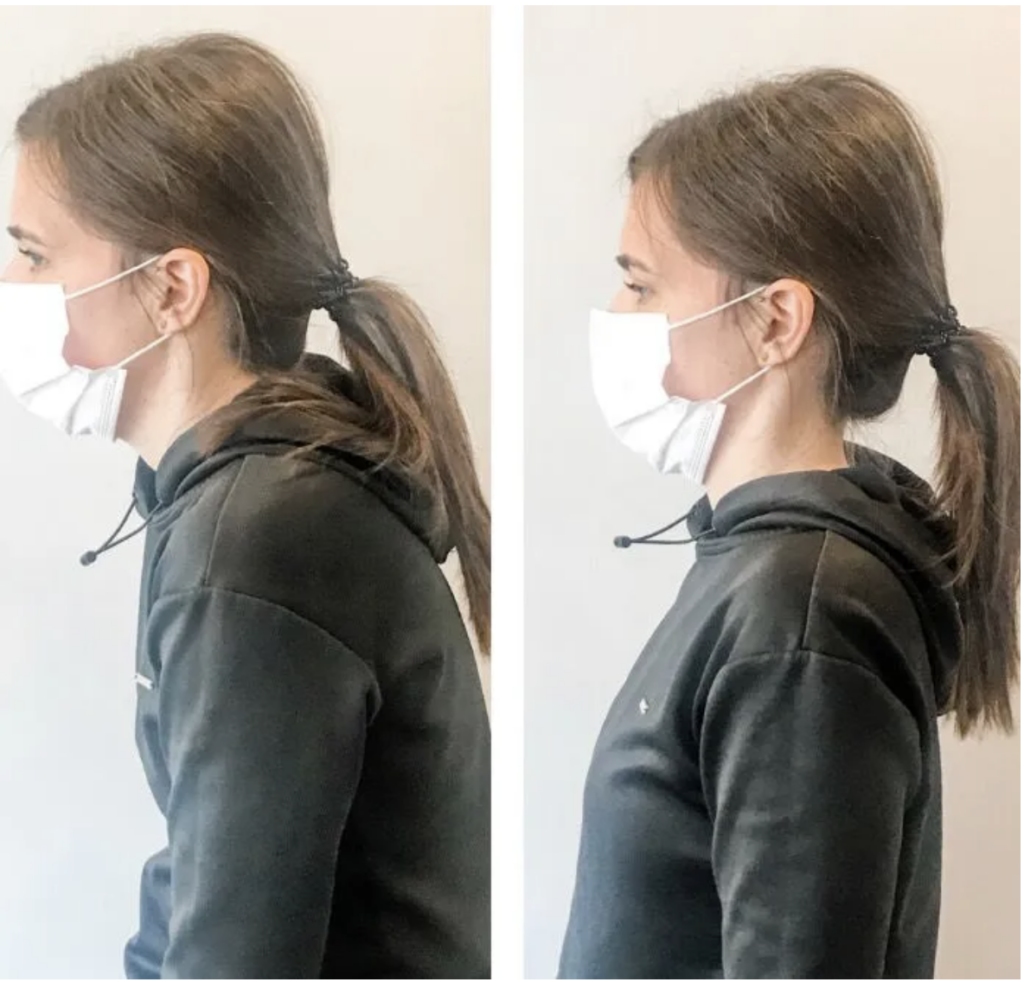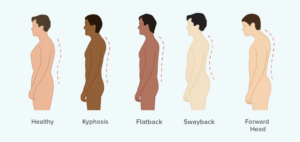Your Celina Chiropractor Teaches: How To Improve Your Posture — Text Neck
Working from home has really started taking its toll. Sitting for 8 hours a day with a makeshift office set-up with less-than-optimal chairs and desks is putting extra strain on the spine and causing text neck. Since Covid, our Chiropractic team has had a huge increase in text neck patients coming to our Celina Chiropractic clinic. Maintaining good posture throughout the day can be difficult, and by the end of the day most people are slouched over their computers trying to get the last bit of work done and start suffering from neck pain. Over this last year, with more people working from home and spending more time than ever on the computer, our Celina chiropractic clinic has seen an influx of neck pain and upper back pain otherwise known as text neck.
What constitutes good posture vs bad posture? Our Celina chiropractor says that there isn’t really a hard and fast rule about posture, but there are some general guidelines that can help align your spine into a more optimal position. Parents, check your kids posture today, if they have the signs of text neck, get them in for an examination today!
Neck Posture and Text Neck Celina Chiropractor
One of the easiest posture flaws to observe is a head/chin that falls too far forward. This is called an ‘anterior head carriage’ or text neck, and it can result in a whole list of postural strains and pains. An anterior head carriage can result from a dysfunctional mid back posture, straining to look at a computer screen, constantly hanging the head to look down at a phone etc. This is becoming the new normal for kids coming to the clinic complaining of everything from headaches and pain to breathing problems and sleeping issues.
An anterior head carriage or text neck creates strain through the muscles that are too long in the front of the neck and short, tight muscles at the base of the skull. The muscles in the front of the neck, called your SCM, can lengthen and become inactive. This can lead to the muscles becoming inactive and developing trigger points, which can refer pain into the front of the head and neck. On the other side of the body, the suboccipitals that are located at the base of the skull, are forced into a shortened position and can also start to refer pain behind the eyes and into the forehead – creating a headache.
There are also a group of muscles that sit along the vertebra in the front of the neck collectively called the deep neck flexors. These muscles can become very inactive and can further perpetuate discomfort caused by this issue. The deep neck flexors are very important postural muscles. They need to be activated to help hold your head up all day long. When they are working effectively, they help take some of the load off the traps, scalene and levator muscles. The ‘deep neck flexors’ can be activated through simple chin tucking exercises. These exercises will help correct anterior head carriage and strengthen the muscles of the cervical spine.
How To Improve Neck Posture and stop Text Neck
Get Adjusted Regularly
Our chiropractor can help make sure your joints move to the best of their ability. The neck is often the area that suffers most from poor posture, and the discomfort can be very debilitating. Poor posture isn’t something that just happens overnight. It is the result of prolonged stresses and positions that reinforce our shoulders and heads to fall forward.
How can adjustments help? Adjustments help to promote movement through the spinal joints. When the joints move as freely as they are supposed to, the spine can rest in a healthy, neutral position. When the spine is neutral, less stresses are put through the joints and that results in less pain and discomfort.
Learn More About How To Correct Posture
Posture Exercises
Stretching and strengthening the neck is one of the best things you can do for your posture. Most people spend hours everyday hunched forward over their computers and cell phones. Posture exercises are designed to help encourage the muscles backwards, into the opposite direction. The exercises we recommend most often also focus on the deep muscles which will help take strain and stress off the bigger, more outer muscles.
DEEP NECK FLEXOR EXERCISES
Strengthening the deep flexors of the neck will help support the head and take some of the pressure off the outer muscles (like trapezius, which often gets too tight when it has to do too much work). When the deep muscles that support the spine are strong and work to the best of their ability it takes a lot of the postural strain off the bigger, outer muscles that can end up taking the brunt of the stress.
POSTURE SPECIFIC EXERCISES
There are also specific exercises for the muscles between the shoulder blades that will prevent the shoulders from slouching forward. These exercises target the middle and lower fibers of the trapezius, rhomboids and lats to help keep the spine upright and prevent it from falling too far forward. These exercises can be progressed gradually to help build the strength required to support an optimal posture.
MidBack Posture
Everyone wants to avoid having a hunched mid back. Nobody wants to be that old man/lady that’s bent so far forward they’re looking at the ground. The thoracic spine is heavily influenced by your day-to-day activities. All the time spent on screens (iPads, computers, cell phones) creates rounded shoulders and a forward posture that in turn affect how the neck and lower back function.
Improve Your Midback Posture With These Exercises
Our mid back should naturally have a little bend, but when that bend becomes excessive it is called a hyperkyphosis. This rounding of the mid back forces our neck into a more unnatural position that increases strain on the muscles of the head and neck. When the thoracic spine is forced into a forward position it can create a feeling of tightness and stiffness. This is where a chiropractic adjustment can feel SO GOOD. One or two adjustments through the middle back (in women, often that bra-line level) can alleviate the stress and tension felt through the spine.
How To Improve Midback Pain
Get Adjusted
Getting adjusted is one of the best things you can do for your mid back. If you’ve never been adjusted before, the middle back is a very easy place to start. It’s a painless adjustment that offers a lot of relief. Chiropractic adjustments are quick, shallow thrusts through restricted joints that can help restore joint movement to their full potential. This helps to improve mobility and relieve pain.
New patients will often ask our Celina chiropractor if the sound of an adjustment is their bones cracking. The answer is no, definitely not. The sound associated with an adjustment is gas being released from the joints. Being adjusted often feels like tension is being released and everything has been decompressed. Our spines were made to move. Adjustments help ensure that they can move optimally.
Exercise
Adjustments are great, but the best thing you can do for yourself is to keep moving. The adjustments are helpful to get stiff joints moving – but the exercises play an important role in keeping everything moving afterwards! There are a number of exercises that are really helpful in promoting movement through the thoracic spine, but we will just highlight a few!
CAT CAMEL
This exercise is really simple and helps move the spine in alternating directions. This is a popular yoga based exercise that moves the spine through alternating flexion and extension movements. It will provide a feeling of being stretched and help the joints feel more loose.
FOAM ROLLING FOR THORACIC SPINE
Foam rollers can be one of the most versatile tools for helping keep your body mobile. Using a foam roll to promote extension through the mid back can be a great home exercise to alleviate mid back pain. We spend so much of our time being hunched forward – the foam roll will help push our spine in the opposite direction.
THORACIC MOBILITY EXERCISES
Thoracic mobility exercises are designed to encourage movement through the middle back. After you spend 8 hours a day in a static position, these exercises will move the spine in the opposite direction and keep you moving!
Don’t wait around for your posture to continue to worsen. Get in today!



 Monday – Friday: 7:00 AM – 6:00 PM | Saturday - Sunday: Closed
Monday – Friday: 7:00 AM – 6:00 PM | Saturday - Sunday: Closed